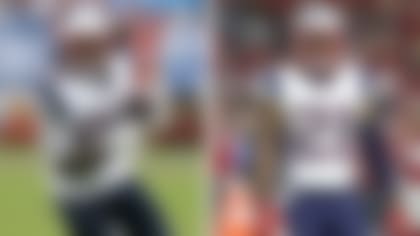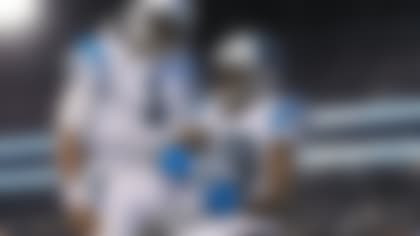Andrew Luck has been celebrated as the next great NFL quarterback since his arrival in the league back in 2012, but the hype is screeching to a halt due to the fourth-year pro's dismal performance so far this season. The former No. 1 overall pick has not only struggled mightily from the pocket, but he is turning the ball over at an alarming rate and costing his team games with scattershot play.
While the football world continues to float a litany of excuses for his poor performance, I thought I'd dig into the All-22 Coaches Film to see what's going on with the young star. Here are three reasons why Luck has been off his game:
1) Andrew Luck is a turnover machine.
For all of the great attributes Luck possesses as a franchise quarterback, he is a gunslinger with a penchant for giving the ball away. The three-time Pro Bowler has committed 79 turnovers in 59 career games (including postseason) -- a significant concern, based on the impact turnovers have on the outcome of games.
Although Luck was expected to turn the ball over a bit as a young quarterback directing a complex offense, the dramatic surge in turnovers over the past season-and-a-half raises questions about his game management skills. Since the beginning of the 2014 campaign, Luck has the most giveaways in the NFL (36 in 24 games, including the postseason), which is mind-boggling when considering his "elite" status in the minds of many scouts, executives and coaches. Based on that statistic alone, it is hard to suggest that Luck is playing winning football at the position.
Speaking of Luck's numbers, I found it interesting that his record's only 6-6 over his past 12 games (including the postseason), completing just 56 percent of his passes and posting a 20:18 touchdown-to-interception ratio. That's not the kind of production expected from a franchise quarterback, particularly one regarded as one of the best QB prospects to enter the NFL since John Elway.
Looking at the All-22 Coaches Film, I see a young quarterback attempting to make too many big plays instead of managing the game from the pocket. Luck routinely bypasses open underneath receivers (checkdowns/safety valves) to force "hero" throws into traffic. While the quarterbacks with rings do push the envelope as playmakers, they also repeatedly take the checkdown option when the defense smothers intermediate and vertical threats.
In the video clip to the right, taken from last week's loss to the New Orleans Saints, Luck tosses an interception on a forced throw when he could've settled for the checkdown in the flat. This poor decision prevented the Colts from taking advantage of a scoring opportunity at the end of the first half.
The dink-and-dunk style isn't sexy for a strong-armed passer, but a patient approach yields big results when electric playmakers turn 5-yard passes into first downs on explosive catch-and-run plays. Given the strong supporting cast surrounding Luck on the perimeter, he should allow his playmakers (T.Y. Hilton, Andre Johnson, Donte Moncrief, Coby Fleener, Dwayne Allen and Frank Gore) to create big plays on short and intermediate throws.
Tom Brady, Aaron Rodgers, Drew Brees and Peyton Manning mastered this strategy fairly early in their respective careers; Luck would be wise to follow the blueprint to help him reduce his turnover woes.
From a coaching perspective, Indianapolis' staff should stress to Luck that stringing together first downs is the offense's ultimate goal. If Luck can get back to focusing on winning the 10-yard war, he will rediscover his rhythm and get the Colts' attack back on track.
2) Indy's offense doesn't feature enough "layups" when Luck's at QB.
Luck certainly deserves to receive his fair share of criticism for recent struggles, but offensive coordinator Pep Hamilton hasn't necessarily helped his quarterback with the game plan. While pairing a vertical aerial assault with a power-oriented ground game can yield big gains on "chunk" plays, the long-ball attack is akin to strictly shooting three-pointers on the basketball court. A hot quarterback can land a few knockout shots, but it is hard to become a 65 percent passer without any layups built into the game plan.
In Luck's case, the deep ball emphasis has resulted in a number of turnovers from the fourth-year pro. In 2015, his numbers on passes of 15-plus air yards are noticeably worse than a season ago. See: The box to the right.
Looking at the coaches tape of the Colts' offense with Luck in the lineup, I was struck by the lack of easy throws (bubble screens, slants, seams and quick outs) that typically help a passer get into a groove. Without those rhythm builders incorporated into the opening script, Luck is rarely able to get comfortable before trying to attack the defense downfield. Consequently, he has struggled in the first half of games throughout the 2015 season (as you can see in the box just below), leading to slow starts from an offense that was expected to light up scoreboards around the NFL.
While some would argue that the Colts' play-action passing game is designed to help Luck get into a groove early by exploiting overaggressive defenses committed to stopping the run with eight-man fronts, Indianapolis' scattershot run game (more on that below...) doesn't command special attention from opponents. Moreover, the constant back-turning on play fakes prevents Luck from spotting late-moving defenders on the second-level. Given Luck's struggles with turnovers, the Colts would be wise to simplify their approach until the QB regains his confidence as a playmaker from the pocket.
To get Luck back on track, the Colts should follow the script used with Matt Hasselbeck in the lineup during his two-game stint as the starter earlier this month, when the franchise QB was hurt. The Colts featured a variety of spread and empty formations on passing downs to create easy throws for the veteran. As a result, Hasselbeck connected on 63.2 percent of his throws, averaged 247.5 passing yards per game and posted a 3:0 TD-to-INT ratio. Most importantly, he led the Colts to a pair of wins, compiling an impressive 95.0 passer rating in the process.
After studying the All-22 film of the Colts' wins over Jacksonville and Houston with Hasselbeck at the helm, I believe Hamilton should feature empty formations prominently in the game plan. While this "spread and shred" approach is typically favored by veteran quarterbacks with high football IQs (see Brady, Manning, Rodgers, Brees, Ben Roethlisberger and Philip Rivers), Luck should thrive in an scheme that allows him to quickly decipher coverage and attack favorable matchups on the perimeter. Additionally, the quick-rhythm passing game associated with empty formations will mask the Colts' O-line deficiencies (15 sacks allowed and a league-high 16 holding penalties) and keep the youngster from taking a beating in the pocket.
Here are some of the passing concepts from empty formation the Colts could use to help Luck find his rhythm from the pocket ...
Against the Jaguars in Week 4, the Colts align in an empty formation with Hilton positioned in the slot. He will run a quick slant against man coverage. Hasselbeck quickly identifies the coverage and delivers a perfect pass to Hilton for a first down (TO VIEW THE PLAY, SCROLL LEFT TO RIGHT ON THE IMAGE BELOW):
One week later, in the game against the Texans, the Colts align in an empty formation with Fleener positioned at the WR2 on the three-receiver side. The Colts run an "Indy" concept (hash-under-under) to the three-receiver side. Fleener uses the hash route by Allen as a pick to get open underneath. Hasselbeck sees the route open up and delivers a perfect pass for a 4-yard gain (TO VIEW THE PLAY, SCROLL LEFT TO RIGHT ON THE IMAGE BELOW):
Later in that Texans game, the Colts align in a "Solo" formation with Johnson and Hilton positioned on the right. Indy is executing a smash concept (hitch-corner) with Hasselbeck sprinting out to the right. The veteran quarterback is instructed to take the hitch unless the cornerback jumps the route. When the cornerback sinks, he drills the ball to Johnson on the hitch. The seven-time Pro Bowl wideout makes a few defenders miss and nets a 23-yard gain on a play that is straight from a high school playbook (TO VIEW THE PLAY, SCROLL LEFT TO RIGHT ON THE IMAGE BELOW):
3) A lackluster run game forces Luck to throw against blanket coverage.
Despite adding one of the most productive backs in NFL history (Frank Gore), the Colts' running game continues to sputter in 2015. Indianapolis ranks 26th in rushing yards and Gore has yet to carve out a 100-yard game. While the veteran wasn't expected to shoulder a heavy workload early in the season -- due to his age and cumulative mileage -- the Colts must find a way to run the ball consistently to alleviate some of the pressure on Luck to carry the offense.
As I studied the All-22 footage looking for clues to explain Luck's struggles, I noticed that the Colts aren't really committed to running the football. The team only rushes on 33.7 percent of their offensive snaps -- that's the fourth-lowest percentage in the NFL. Given the lack of persistence the Colts have shown with their running game, it is not surprising that teams primarily are trotting out coverage-based tactics that force Luck to throw against extra defenders down the field.
To reverse the trend, the Colts must diligently attempt to run the ball in the upcoming weeks and force opponents to respect the ground game. Hamilton must ignore the production and focus on getting 30 rushing attempts in each game. Although minimal gains could produce long-yardage situations, the team must stay committed to achieving better balance to prevent defenses from teeing off on their franchise quarterback.
Studying the coaches tape on Gore, I see a veteran with just enough juice to anchor a ground attack. Granted, he has struggled with ball-security issues near the goal line, but he remains a viable threat as an early-down runner. Gore is averaging 4.6 yards an attempt, exhibiting the same vision, balance and body control that has allowed him to notch eight 1,000-yard seasons in his career. Given his production and performance, Indy would be wise to put more on the shoulders of the veteran.
If the Colts want to make a life easier on their quarterback, they must lean on Gore and let him resume his role as a workhorse back.
Follow Bucky Brooks on Twitter @BuckyBrooks.












